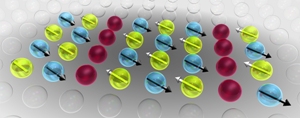Superconducting materials, which transmit power resistance-free, are found to perform optimally when high- and low-charge density varies on the nanoscale level, according to research performed at the Department of Energy's Oak Ridge National Laboratory.
In research toward better understanding the dynamics behind high-temperature superconductivity, the ORNL scientists rewrote computational code for the numerical Hubbard model that previously assumed copper-compound superconducting materials known as cuprates to be homogenous — the same electron density — from atom to atom.
 Researchers have found that atom clusters with inhomogenous stripes of lower density (shown in red) raise critical temperature needed to reach superconductor state.
Researchers have found that atom clusters with inhomogenous stripes of lower density (shown in red) raise critical temperature needed to reach superconductor state.
Lead author Thomas Maier and colleagues Gonzalo Alvarez, Michael Summers and Thomas Schulthess received the Association for Computing Machinery Gordon Bell Prize two years ago for their high-performance computing application. The application has now been used to examine the nanoscale inhomogeneities in superconductors that had long been noticed but left unexplained.
The paper is published in Physical Review Letters.
"Cuprates and other chemical compounds used as superconductors require very cold temperatures, nearing absolute zero, to transition from a phase of resistance to no resistance," said Jack Wells, director of the Office of Institutional Planning and a former Computational Materials Sciences group leader.
Liquid nitrogen is used to cool superconductors into phase transition. The colder the conductive material has to get to reach the resistance-free superconductor phase, the less efficient and more costly are superconductor power infrastructures. Such infrastructures include those used on magnetic levitation trains, hospital Magnetic Resonance Imaging, particle accelerators and some city power utilities.
In angle-resolved photoemission experiments and transport studies on a cuprate material that exhibits striped electronic inhomogeneity, scientists for years observed that superconductivity is heavily affected by the nanoscale features and in some respect even optimized.
"The goal following the Gordon Bell Prize was to take that supercomputing application and learn whether these inhomogenous stripes increased or decreased the temperature required to reach transition," Wells said. "By discovering that striping leads to a strong increase in critical temperature, we can now ask the question: is there an optimal inhomogeneity?"
In an ideal world, a material could become superconductive at an easily achieved and maintained low temperature, eliminating much of the accompanying cost of the cooling infrastructure.
"The next step in our progress is a hard problem," Wells said. "But from our lab's point of view, all of the major tools suited for studying this phenomenon — the computational codes we've written, the neutron scattering experiments that allow us to examine nanoscale properties — are available to us here."
Source: http://www.ornl.gov/